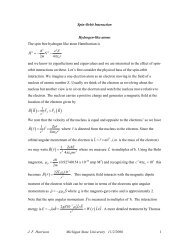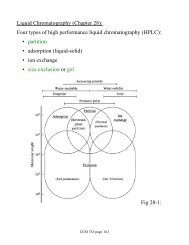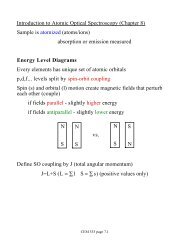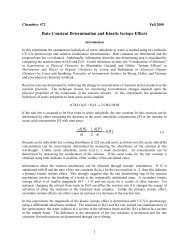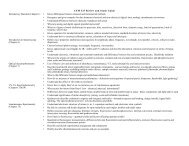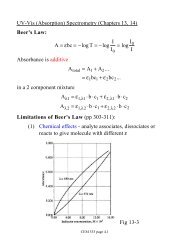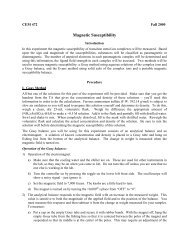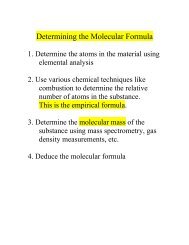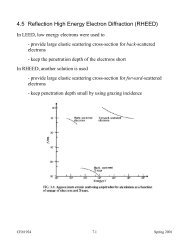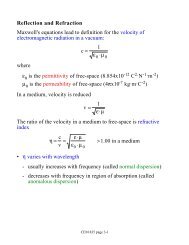SERS Surface Enhanced Raman Spectroscopy
SERS Surface Enhanced Raman Spectroscopy
SERS Surface Enhanced Raman Spectroscopy
- No tags were found...
You also want an ePaper? Increase the reach of your titles
YUMPU automatically turns print PDFs into web optimized ePapers that Google loves.
6Effective <strong>SERS</strong> cross-sections, however, can be as good as ~10 -18 cm 2 / molecule for Rhodamine 6G and similardyes. The theoretical estimates for the needed cross-section for single molecule detection using <strong>SERS</strong> is 4 x 10 –18cm 2 / molecule.It is interesting to note analyte aggregation inhibits the effectiveness of <strong>SERS</strong>. That is, the most effective andreproducible <strong>SERS</strong> spectra occur for analytes of concentrations about equal to the concentration of metal particlesites. 8 <strong>SERS</strong> has the potential to combine the structural information provided by RS with the sensitivity typicallyseen in fluorescence spectroscopy.Overlayer TechniquesThe distance dependence of <strong>SERS</strong> is utilized in the overlayer technique, wherein an ultrathin film of solid orliquid is adsorbed onto the <strong>SERS</strong>-active substrate and the analyte within the film can borrow the EME of thesubstrate and have its <strong>Raman</strong> spectra greatly enhanced. This makes <strong>SERS</strong> applicable to organic films,semiconductors, insulators, etc. 14 Spacer layers can be adsorbed onto the substrate, and can alter the chemistry ofeither the substrate or overlayer, increasing the utility of <strong>SERS</strong> still further. An advantage to the overlayertechnique is that it diminishes the inhibiting effect of metal surface defects, such as pinholes in silver. 14,15Since the primary enhancement in <strong>SERS</strong> is due to an electromagnetic effect and any em field decreases instrength with distance from the point source, it follows that an analyte could benefit from the enhancement of a<strong>SERS</strong>-active substrate even if that analyte were some distance away from the enhancing surface. Theoreticalcalculations have been conducted, and the <strong>SERS</strong> enhancement, G, has been found to scale with distanceaccording toG = [ r / ( r + d ) ] 12where r is the radius of the spherical metal roughness feature and d is the distance of the analyte to that feature.Experimentally, the enhancement decreases ten-fold with a distance of 2-3 nm; a distance of 20-30 Å, or amonolayer or two. 2,8,14The transition metals do not typically give good <strong>SERS</strong> spectra, but Pd, Pt, Rh, and Ir, are useful in catalyticsystems, so it would be helpful to optimize these metals for <strong>SERS</strong>. Zou, et al. make use of the distancedependence of <strong>SERS</strong> by laying transition metals over a <strong>SERS</strong> active substrate, so that studies at the transitionmetal surface can be conducted with the analytes or transition metal benefiting from the enhancement of theunderlying <strong>SERS</strong> substrate. This approach also minimizes the ‘pinhole’ problem common in gold; that is, surfacedefects can greatly alter <strong>SERS</strong> efficiency and analyte adsorption thermodynamics. Deposition of a few ultrathinlayers of metal onto the gold removes the effects of the pinhole sites.



